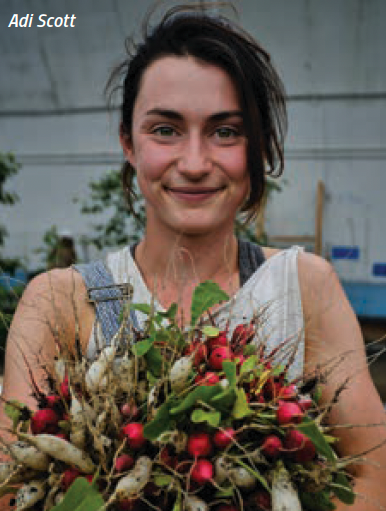
Growing in the land of the midnight sun
A former residential school hockey arena is transformed into a vibrant community greenhouse
BY GAIL POPE
Located on the Mackenzie River Delta, two degrees above the Arctic Circle, the Inuvik Community Greenhouse (ICG) is the largest northern greenhouse in North America and perhaps even the world. It’s also one of the most unique, with over 16,000 square feet of space in what was previously a hockey arena.
The facility, which belonged to Grollier Hall, the town’s former residential school, was saved from demolition when the Community Garden Society of Inuvik (CGSI) was formed in 1998 to raise funds and petition to transform the hockey arena into a community greenhouse.
The transformation and its impact on the Inuvik community was examined in a Carleton University study titled: Community Healing through Gardening: the Inuvik Community Greenhouse and reuse of the Grollier Hall Hockey Arena.
“The Inuvik Community Greenhouse stands as an unusual example of adaptive reuse that demonstrates how to provide an alternative way for food security through a socio-cultural and economic model,” the study says. “Committed to ‘building a strong sense of community through recreational gardening, food production, knowledge sharing, and volunteer support’ (Public Health Agency of Canada, 2009), the efforts exerted by the CGSI led to inspiring outcomes. Based upon the success to date, CGSI believes the Inuvik Community Greenhouse serves as an effective model for other northern communities.”
 Adi Scott, greenhouse coordinator, says food production and community are the most important roles of the ICG.
Adi Scott, greenhouse coordinator, says food production and community are the most important roles of the ICG.
Inuvik is known as the land of the midnight sun because it has 56 days with 24 hours of daylight in the summer and 30 days of darkness in the winter. The constant summer sun makes for a great — albeit relatively short and extreme — growing season. The controlled greenhouse system allows for plants to grow from May to October, whereas the hydroponic unit grows crops all year round.
Hydroponic systems grow plants without using soil. Instead, growers use nutrient-rich water-based formulas that provide the plant with its exact environmental needs. This includes using devices that monitor pH levels and sun exposure, which are adjusted accordingly.
In the northern regions of Canada exorbitant food costs continue to be a major problem. Adi Scott, greenhouse coordinator, says food production and community are the most important roles of the ICG.
 “On the first Thursday of each month, while we’re growing, we aim to add fresh greens and produce to the food bank’s non-perishable hampers. We also provide recipe cards so people can learn how to use the veggies that we’re providing,” Scott said. “We provide this all for free, which we would never be able to do without all the generous funding from people and organizations.”
“On the first Thursday of each month, while we’re growing, we aim to add fresh greens and produce to the food bank’s non-perishable hampers. We also provide recipe cards so people can learn how to use the veggies that we’re providing,” Scott said. “We provide this all for free, which we would never be able to do without all the generous funding from people and organizations.”Scott explained how the greenhouse is supported by donors and the money raised by their various fundraisers throughout the year.
“We also have a cafe that sells tea and things made from the garden,” Scott said. “We try to teach people about the medicinal qualities that they have, but the real focus is trying to promote well-being and community gathering.”
Families and individuals can become members of the greenhouse to gain access to workshops, food programs, plot rentals, and more. To rent a plot, there is also a small community requirement.
“Each plot is five volunteer hours and that could be helping us around the greenhouse, helping to run events or to run workshops,” Scott explained. “Really, the idea of those volunteer hours is to get more community involvement.”
The greenhouse is not only a valuable source of food for the community, but also a place where everyone can come together to build relationships.
“We have so many different age groups, and then we also have families. I believe there are more than 50 visible minorities. It’s a high number for such a small community,” Scott said.
 Inuvik is known as the land of the midnight sun because it has 56 days with 24 hours of daylight in the summer and 30 days of darkness in the winter.
Inuvik is known as the land of the midnight sun because it has 56 days with 24 hours of daylight in the summer and 30 days of darkness in the winter.
Inuvik is home to just over 3,200 people, and has a large Indigenous population. Scott explained how important it is for people in the North to have spaces where they can connect and facilitate learning more about their culture through plants and growing. To encourage learning, the greenhouse offers workshops to youth and adults on all sorts of topics, including how different plants can be used for medicine.
Scott said, “We also aim to facilitate workshops and events, focusing on how to make and dehydrate products for the winter or for sale. We also explain the medical uses and healing properties of plants, which is an important aspect in Indigenous culture too. We try to make it as relevant as possible to all cultures in our community.”
As the Carleton University study says, this unique community greenhouse demonstrates “that the dark symbol of the Indian Residential School in Inuvik’s history can be transformed into an emblem of hope to boost food security in the Town of Inuvik.”